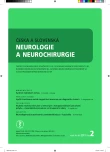Radiation-Induced Meningiomas
Authors:
R. Jančálek 1; Z. Novák 1; J. Chrastina 1; B. Slaná 2; V. Feitová 3
Authors‘ workplace:
LF MU a FN u sv. Anny v Brně
Neurochirurgická klinika
1; LF MU a FN u sv. Anny v Brně
I. patologicko-anatomický ústav
2; LF MU a FN u sv. Anny v Brně
Klinika zobrazovacích metod
3
Published in:
Cesk Slov Neurol N 2011; 74/107(2): 191-196
Category:
Short Communication
Overview
Radiotherapy has recently become a standard procedure for the treatment not only of high-grade intracranial tumours but also of some of benign nature. Despite its therapeutic potential, radiotherapy can act as a trigger for carcinogenesis. Meningiomas are the most frequent intracranial tumours induced by radiotherapy because the radiosensitivity of meningeal tissue is high. Radiation-induced meningiomas differ from spontaneous meningiomas in their higher incidence in younger age groups. They are also more frequently multiple with histological abnormalities and a higher incidence of recurrence. First-choice therapy for radiation-induced meningiomas is surgical. Stereoradiosurgery appears to be the treatment of choice for progressive meningiomas in locations inaccessible to surgical approach. Three cases of radiation-induced meningiomas were found in a retrospective study of patients treated at the Department of Neurosurgery, St. Anne’s University Hospital, Brno. In conclusion, radiation-induced meningiomas form a specific group. Their specific features should be borne in mind in the course of oncology care.
Key words:
radiation-induced meningiomas – features – therapy
Sources
1. HQ, Higinbotham NL, Stewart FW, Coley BL. Sarcoma arising in irradiated bone: report of eleven cases. Cancer 1998; 82(1): 8–34.
2. Breen P, Flickinger JC, Kondziolka D Martinez AJ. Radiotherapy for nonfunctional pituitary adenoma: analysis of long-term tumor control. J Neurosurg 1998; 89(6): 933–938.
3. Laws ER jr, Vance ML. Radiosurgery for pituitary tumors and craniopharyngiomas. Neurosurg Clin N Am 1999; 10(2): 327–336.
4. Cantini R, Giorgetti W, Valleriani AM, Burchianti M Amodeo C. Radiation-induced cerebral lesions in childhood. Childs Nerv Syst 1989; 5(3): 135–139.
5. Dweik A, Maheut-Lourmiere J, Lioret E, Jan M. Radiation-induced meningioma. Childs Nerv Syst 1995; 11(11): 661–663.
6. Sznajder L, Abrahams C, Parry DM, Gierlowski TC, Shore-Freedman E, Schneider AB. Multiple schwannomas and meningiomas associated with irradiation in childhood. Arch Intern Med 1996; 156(16): 1873–1878.
7. Sadetzki S, Flint-Richter P, Ben-Tal T, Nass D. Radiation-induced meningioma: a descriptive study of 253 cases. J Neurosurg 2002; 97(5): 1078–1082.
8. Rubinstein AB, Shalit MN, Cohen ML, Zandbank U Reichenthal E. Radiation-induced cerebral meningioma: a recognizable entity. J Neurosurg 1984; 61(5): 966–971.
9. Harrison MJ, Wolfe DE, Lau TS, Mitnick RJ Sachdev VP. Radiation-induced meningiomas: experience at the Mount Sinai Hospital and review of the literature. J Neurosurg 1991; 75(4): 564–574.
10. D‘Ambrosio AL, Bruce JN. Treatment of meningioma: an update. Curr Neurol Neurosci Rep 2003; 3(3): 206–214.
11. Pollock BE, Stafford SL, Utter A, Giannini C, Schreiner SA. Stereotactic radiosurgery provides equivalent tumor control to Simpson Grade 1 resection for patients with small - to medium-size meningiomas. Int J Radiat Oncol Biol Phys 2003; 55(4): 1000–1005.
12. Liscák R, Simonová G, Vymazal J, Janousková L Vladyka V. Gamma knife radiosurgery of meningiomas in the cavernous sinus region. Acta Neurochir (Wien) 1999; 141(5): 473–480.
Labels
Paediatric neurology Neurosurgery NeurologyArticle was published in
Czech and Slovak Neurology and Neurosurgery

2011 Issue 2
- Metamizole vs. Tramadol in Postoperative Analgesia
- Memantine in Dementia Therapy – Current Findings and Possible Future Applications
- Metamizole at a Glance and in Practice – Effective Non-Opioid Analgesic for All Ages
- Advances in the Treatment of Myasthenia Gravis on the Horizon
Most read in this issue
- Restless Legs Syndrome
- Treatment of Peroneal Nerve Injury by Operation
- Sudden Dyspnoea as a First Symptom Leading to a Diagnosis of Amyotrophic Lateral Sclerosis – a Case Report
- Invasive Fungal Sinusitis
